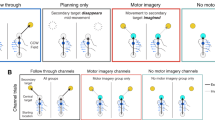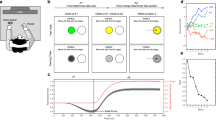Abstract
Sensorimotor adaptation and sequence learning have often been treated as distinct forms of motor learning. But frequently the motor system must acquire both types of experience simultaneously. Here, we investigated the interaction of these two forms of motor learning by having subjects adapt to predictable forces imposed by a robotic manipulandum while simultaneously reaching to an implicit sequence of targets. We show that adaptation to novel dynamics and learning of a sequence of movements can occur simultaneously and without significant interference or facilitation. When both conditions were presented simultaneously to subjects, their trajectory error and reaction time decreased to the same extent as those of subjects who experienced the force field or sequence independently.


Similar content being viewed by others
References
Brashers-Krug T, Shadmehr R, Bizzi E (1996) Consolidation in human motor memory. Nature 382:252–255
Caithness G, Osu R, Bays P, Chase H, Klassen J, Kawato M, Wolpert DM, Flanagan JR (2004) Failure to consolidate the consolidation theory of learning for sensorimotor adaptation tasks. J Neurosci 24:8662–8671
Donchin O, Sawaki L, Madupu G, Cohen LG, Shadmehr R (2002) Mechanisms influencing acquisition and recall of motor memories. J Neurophysiol 88:2114–2123
Doyon J, Penhune V, Ungerleider LG (2003) Distinct contribution of the cortico-striatal and cortico-cerebellar systems to motor skill learning. Neuropsychologia 41:252–262
Ghilardi M, Ghez C, Dhawan V, Moeller J, Mentis M, Nakamura T, Antonini A, Eidelberg D (2000) Patterns of regional brain activation associated with different forms of motor learning. Brain Res 871:127–145
Goedert KM, Willingham DB (2002) Patterns of interference in sequence learning and prism adaptation inconsistent with the consolidation hypothesis. Learn Mem 9:279–292
Hikosaka O, Nakahara H, Rand MK, Sakai K, Lu X, Nakamura K, Miyachi S, Doya K (1999) Parallel neural networks for learning sequential procedures. Trends Neurosci 22:464–471
Imamizu H, Miyauchi S, Tamada T, Sasaki Y, Takino R, Putz B, Yoshioka T, Kawato M (2000) Human cerebellar activity reflecting an acquired internal model of a new tool. Nature 403:192–195
Jenkins IH, Brooks DJ, Nixon PD, Frackowiak RS, Passingham RE (1994) Motor sequence learning: A study with positron emission tomography. J Neurosci 14:3775–3790
Karni A, Meyer G, Rey-Hipolito C, Jezzard P, Adams MM, Turner R, Ungerleider LG (1998) The acquisition of skilled motor performance: fast and slow experience-driven changes in primary motor cortex. Proc Natl Acad Sci USA 95:861–868
Kassardjian CD, Tan YF, Chung JY, Heskin R, Peterson MJ, Broussard DM (2005) The site of a motor memory shifts with consolidation. J Neurosci 25:7979–7985
Korman M, Raz N, Flash T, Karni A (2003) Multiple shifts in the representation of a motor sequence during the acquisition of skilled performance. Proc Natl Acad Sci USA 100:12492–12497
Lehéricy S, Benali H, Van de Moortele P-F, Pélégrini-Issac M, Waechter T, Ugurbil K, Doyon J (2005) Distinct basal ganglia territories are engaged in early and advanced motor sequence learning. Proc Natl Acad Sci USA 102:12566–12571
Nissen MJ, Bullemer PT (1987) Attentional requirements for learning: Evidence from performance measures. Cognit Psychol 19:1–32
Press DZ, Casement MD, Pascual-Leone A, Robertson EM (2005) The time course of off-line motor sequence learning. Brain Res Cogn Brain Res 25:375–378
Richardson AG, Overduin SA, Valero-Cabre A, Padoa-Schioppa C, Pascual-Leone A, Bizzi E, Press DZ (2006) Disruption of primary motor cortex before learning impairs memory of movement dynamics. J Neurosci 26:12466–12470
Robertson EM, Pascual-Leone A, Miall RC (2004) Current concepts in procedural consolidation. Nat Rev Neurosci 5:1–7
Schendan HE, Searl MM, Melrose RJ, Stern CE (2003) An fMRI study of the role of the medial temporal lobe in implicit and explicit sequence learning. Neuron 37:1013–1025
Seidler RD (2004) Multiple motor learning experiences enhance motor adaptability. J Cogn Neurosci 16:65–73
Shadmehr R, Brashers-Krug T (1997) Functional stages in the formation of human long-term motor memory. J Neurosci 17:409–419
Shadmehr R, Holcomb HH (1997) Neural correlates of motor memory consolidation. Science 277:821–825
Shadmehr R, Mussa-Ivaldi FA (1994) Adaptive representation of dynamics during learning of a motor task. J Neurosci 14:3208–3224
Shadmehr R, Brandt J, Corkin S (1998) Time-dependent motor memory processes in amnesic subjects. J Neurophysiol 80:1590–1597
Shin JC, Ivry RB (2003) Spatial and temporal sequence learning in patients with Parkinson’s disease or cerebellar lesions. J Cogn Neurosci 15:1232–1243
Wainscott SK, Donchin O, Shadmehr R (2005) Internal models and contextual cues: Encoding serial order and direction of movement. J Neurophysiol 93:786–800
Walker MP, Brakefield T, Hobson JA, Stickgold R (2003) Dissociable stages of human memory consolidation and reconsolidation. Nature 425:616–620
Watanabe K, Ikeda H, Hikosaka O (2006) Effects of explicit knowledge of workspace rotation in visuomotor sequence learning. Exp Brain Res 174:673–678
Willingham DB, Goedert-Eschmann K (1999) The relation between implicit and explicit learning: Evidence for parallel development. Psychol Sci 10:531–534
Willingham DB, Nissen MJ, Bullemer P (1989) On the development of procedural knowledge. J Exp Psychol Learn Mem Cogn 15:1047–1060
Acknowledgments
We thank Martin Ramos Rizo-Patron, Christi Winiarz and Courtney Lane for technical assistance. This work was supported by grant NIH K23-MH65434 to D.Z.P.
Author information
Authors and Affiliations
Corresponding author
Rights and permissions
About this article
Cite this article
Overduin, S.A., Richardson, A.G., Bizzi, E. et al. Simultaneous sensorimotor adaptation and sequence learning. Exp Brain Res 184, 451–456 (2008). https://doi.org/10.1007/s00221-007-1213-8
Received:
Accepted:
Published:
Issue Date:
DOI: https://doi.org/10.1007/s00221-007-1213-8




